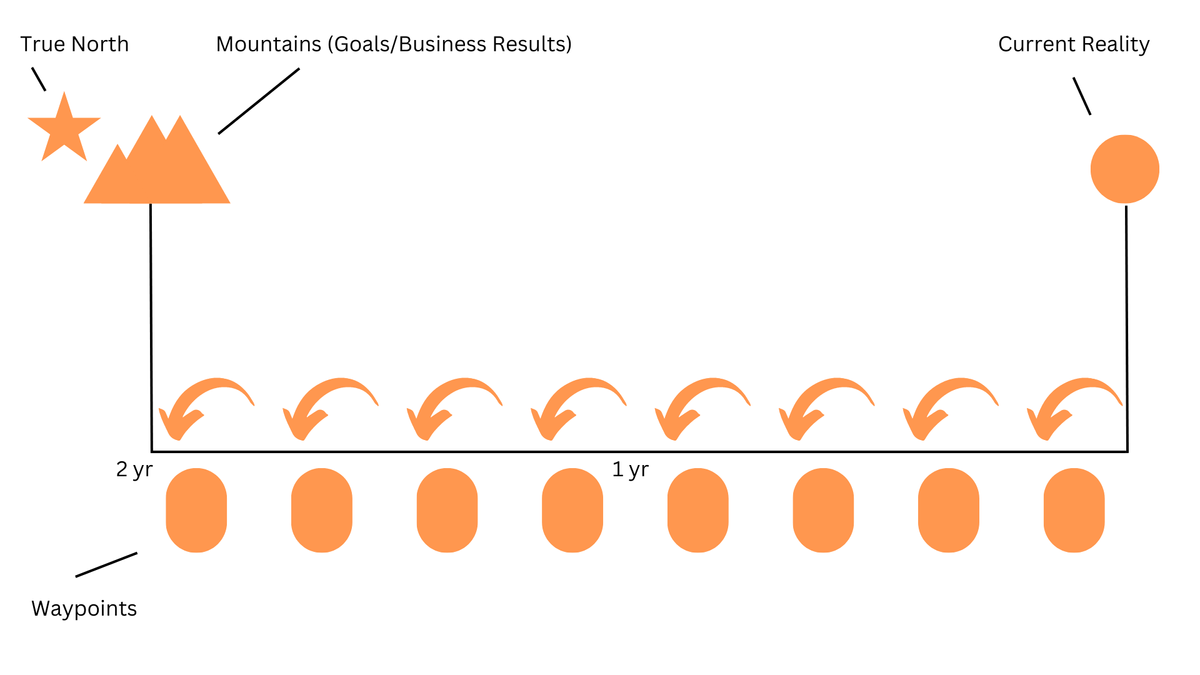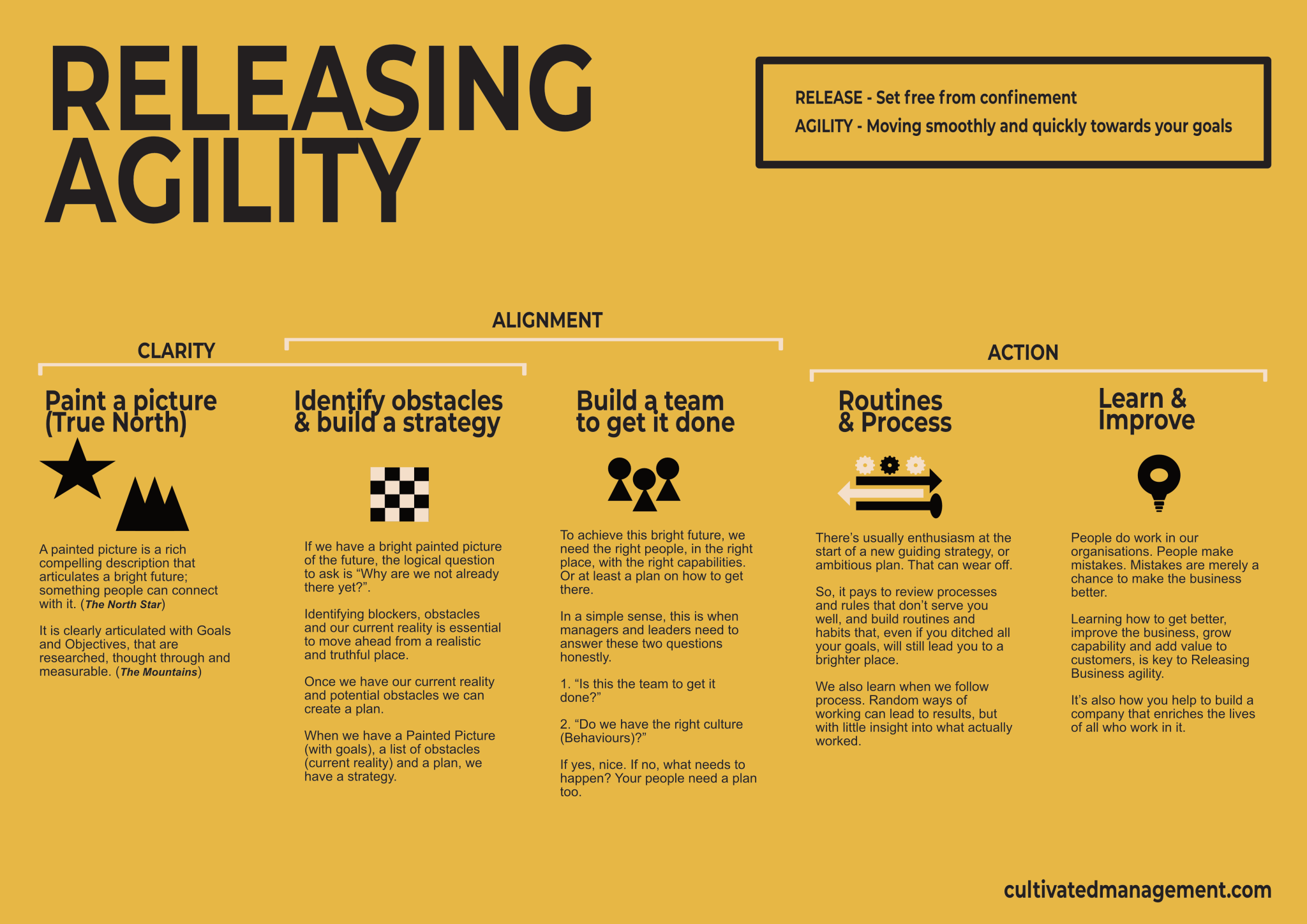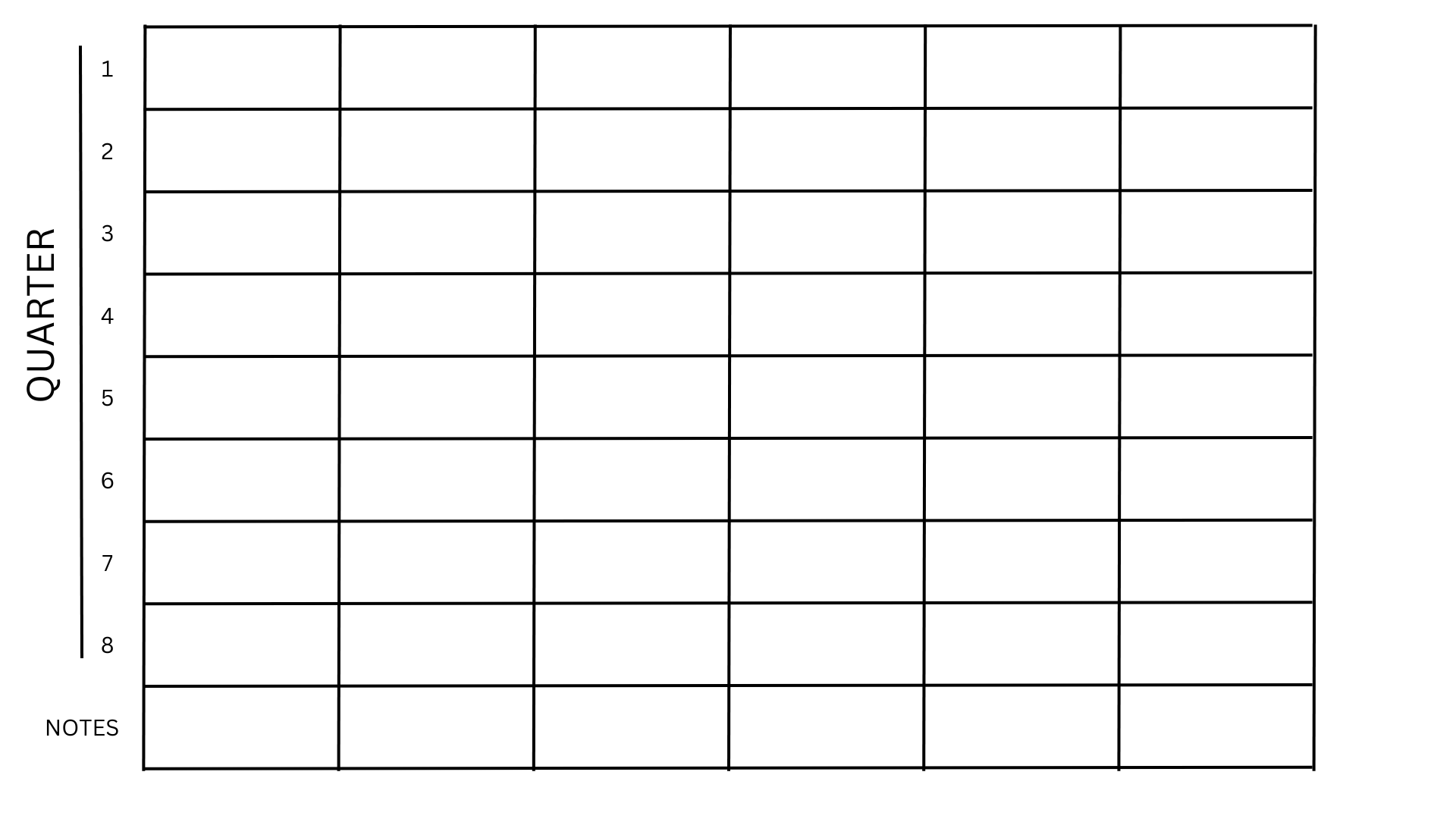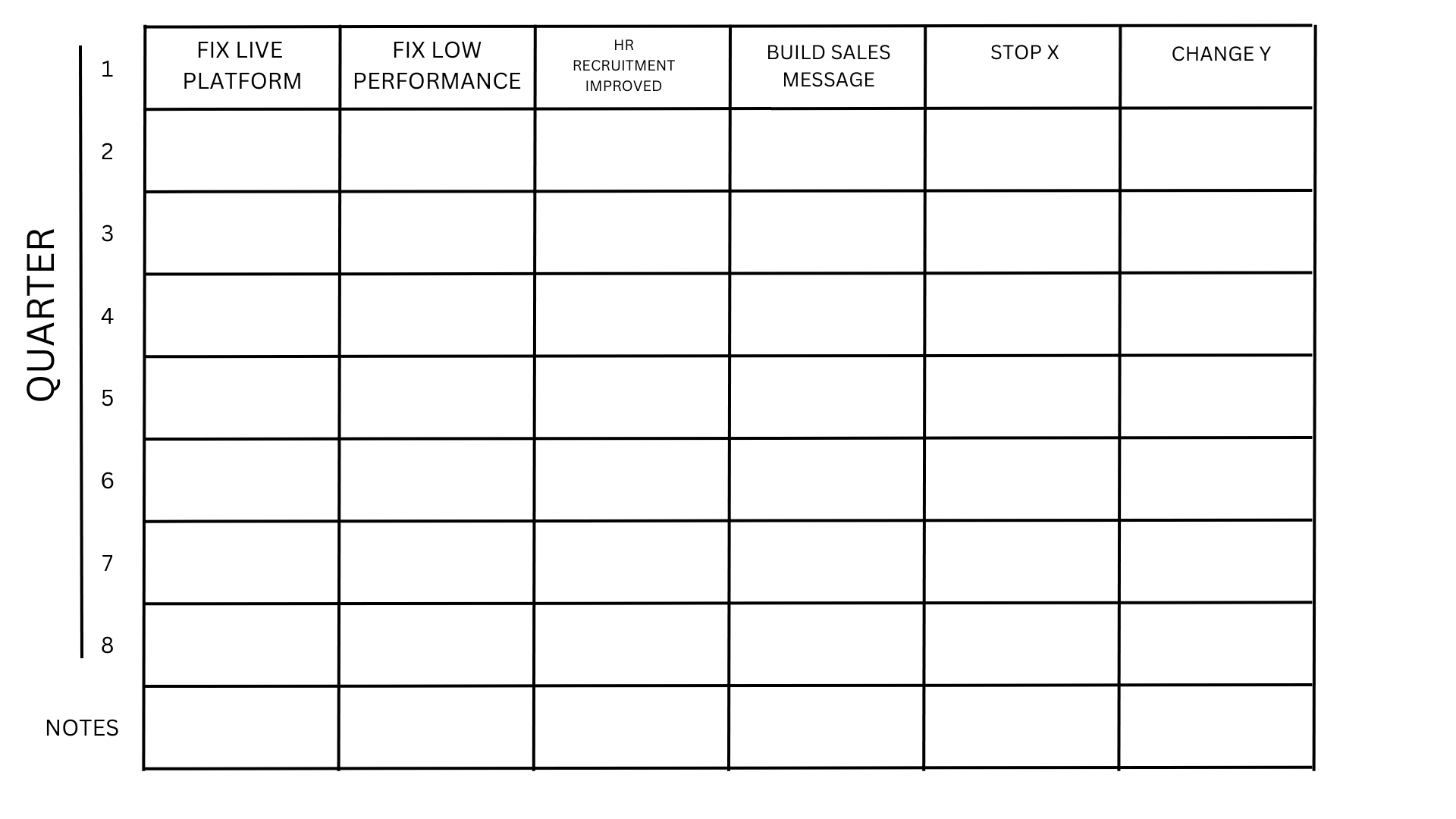
Regular readers will know that I help companies imagine bright futures and Release Agility towards these bright futures.
The model I use is here:

As part of this work I run “future casting” immersive workshops, where we explore imagining (and building a real physical representation of) a bright, compelling and interesting future. A future so exciting that people want to join you to bring this future to life.
Part of these immersive workshops is defining (and building a physical model) of the future. As part of this session we cover three core aspects, and today I will share just one exercise I thought you may find helpful (the back casting activity).
True North - Painted Picture + Goals
Firstly, we build a True North or, as I call it, a painted picture of the future.
This is a description of the value you bring, the kind of company you want to be and an interesting account of how the business will be different. The models that leaders build in the workshop, are representations of this bright future.
We often create a poster, sometimes a painting – and sometimes, a physical star with descriptions written on it.
As part of this True North painted picture, we also then build physical representations of mountains.
These mountains are on the horizon we are heading towards, which we believe will lead us to the bright painted picture of the True North.
These mountains represent goals, outcomes and business results. The things we’re heading towards. The things we can write down and measure. Business Results.
When we reach the mountains we still won’t reach the True North Painted Picture.
Why? Because we never will – that’s how ambitious and lofty the True North is – a kind of perfect state that we can feel, touch and sense, but will always be slightly out of reach.
The mountains though are tangible. They are the things we will deliver – and in doing so, we will make the business better, stronger and more profitable.
We then run the back casting activity which I thought might be interesting for you to try yourself.
The Back Casting Activity
The goal of the back casting activity is to build a tactical plan to move towards the mountains (our goals) – you could consider it a map of sorts, but I refer to it as a grid.
Through the back casting activity we identify waypoints towards the goals, and then populate a grid which becomes the foundations for our action plan.
For this session we use two props.
One is the back casting line and the other is a grid (typically 6×8). I’ll introduce the back casting line first, and then the grid.
The back casting line
Draw your Mountains (Business Goals) on the left hand side of a large whiteboard, Mural or large paper sheet. Then write “current reality” on the right hand side at the opposite end of the wall/paper/tool.

The leaders and managers then set a number of waypoints on the line you draw between the two.
I typically ask them to draw 8 waypoints – to represent a two year journey, of 4 quarters per year.
Different horizons will yield different waypoints, so use your judgment on what makes sense. A 5-year plan will yield big (vague) waypoints, a 1-year plan will yield more tangible and descriptive waypoints.
I usually go for two years – 8 way points – simple.
At each waypoint the leaders and managers should explore, brainstorm and co-create how the business will be different.
***An important part of this though, is that they should start at the last waypoint, the one before the Mountains. This is important. ***
You want them to imagine how the business (process, people, themselves, products etc) looks just before they reach their business results/goals (in this case, in two year’s time).
This can be a hard task to do, but with a few ideas thrown in, some good facilitation and some time and space, they often get there.
It doesn’t have to be perfect.
Some people cannot step out of simply imagining a linear path from their current knowledge of the business. There are exercises to help with this thinking such as anticipating the future using archetypes and future cones.
Once they have this “last waypoint” describing a smooth running business before hitting their goals, work backwards from there.
Be careful of more
More of the same equals more of the same
Be careful to keep an eye on “growth” as a solution, such as:
- “We’ll have more people”
- “We’ll have investment”
- “We’ll push into X market”
These may be ok, but the reality is the journey is often more about stopping some work, optimising routines, dealing with low performance, fixing systemic issues, rather than throwing “more” at a business with problems.
More of the same problems creates more of the same problems.
Agility is released by removing what is stopping you, and solving problems in their entirety - not by throwing more people, money and resources at it. Being a BIG company is surely not the goal - being effective and profitable is; big may simply be a side effect.
What gets written at each waypoint is not set in stone – nor will it be right the first time, so use post-it notes or something that can be moved/erased.
For example, they may write, at the last waypoint such, “the live platform is now stable and running 99.9% uptime”.
In reality, after discussions and arguments, they realise that this could realistically be done WAY before the last waypoint. Maybe it could be done in a quarter from now, and unlocks further opportunities. So, move it to the most appropriate waypoint.
These way points are just guides towards the mountains. They are checkpoints that can be written down as sub-goals and targets for the business. Consider them milestones.
For example:
By the end of Q1 we will have fixed the live platform, dealt with low performance, implemented a HR recruitment policy and aligned our sales team on core messaging.
This session is not about building the actual detailed action plan, but rather defining some high level checkpoints and sub-goals, that need to be in place.
Turning these waypoints into action should be done after the session, captured in the appropriate work management tool.
For this particular example it could be:
- Stop X work and divert people to fixing the platform
- Move hosting to AWS
- Fix the telemetrics and tracing so we can see what is happening
The Grid
Applying constraints to ambitions
The Grid
Once the back casting activity is complete, it’s now time to add some of these items to the grid. Here is the empty grid that I use.

The grid serves as a constraint – there are only 6 spaces across for each quarter. 6 tactical things to solve. 6 problems to overcome. 6 tactical ideas that will move you towards the first way point. (Modify your grid to include the number of way points identified against the horizon you have chosen).
They may have more than 6, and that is fine, but the reality is we are working in quarters, and aiming big, so it may be that they are taking on more than they can deliver. A worthy discussion point.
I tend to heavily encourage 6 problems/initiatives a quarter.
We now need to add the waypoint information to the grid.

Add all of the milestones / waypoints defined earlier to thPostse grid.
The grid will now fill with incremental changes to the business – future mini-states that will enhance the business towards the Mountains (Business Results).
These are waypoints that we can track and measure as we move through the year(s).
Stand back. Cry a little, and then rejoice in having something that resembles an ambitious, but well thought through strategy.
Filling in the grid completes the strategic work (for now) and is usually the element I see missing most from strategies.
Many leaders have an idea about what they want their business to look like (True North), they often have some goals and objectives (Mountains), but they often fail to lean into the current reality (meaning they are moving from an unquantifiable starting point) and they often don’t discuss or lean into the problems on the journey (The Grid).
The grid gives you the tactical plan needed to build an incrementally better business, towards your business goals – which in turn are leading to a brighter future.
The grid is the tactical work.
Once we have a full grid we have everything we need (almost) to say we have a strategy.
- We have a bright painted picture of the future. (True North)
- We have goals and measures of success that we absolutely are moving towards (Mountains)
- We have our current reality, way points and a tactical plan (Grid)
Now we need owners and more detailed plans for each tactical element – and this needs putting into the work management tool of choice.
It then needs prioritising against business as usual and other initiatives. A hard task. Some the work identified in this exercise will be tactical improvement work, some will be people related work, some will be product or service related work.
Most leaders will merely add this tactical work on top of existing work. The challenge is your people are likely already busy doing good work - so you need to find ways to make space for this work too.
It's not a great strategy to fill everyones capacity - instead, something else must stop to make space and achieve flow.
So, I always ensure, as part of the Back Casting exercise, that they discuss and understand what has to STOP as well as what needs doing.
This strategy also needs communicating (not merely broadcasting) through the organisation to galvanise people around it. This is done with a solid communication plan, repetition, repetition, repetition and rippling of comms through the managers and leaders.
We also need these waypoints in our calendars, and regular reviews to manage progress against them. We don't want Watermelon reporting, so it's essential this work is captured in a work productivity tool and reporting standards are defined.
The power of this activity is that we haven’t laid out a rock solid unchangeable plan. We haven’t codified the details of “how” we will achieve these waypoints – we’re encouraging the teams to do this. They are best placed.
We simply have ambitious way points that we know will lead us to our bright future.
I also encourage leaders to socialise the plan and take feedback, but don’t be swayed too much by strong opinions (especially when they aren’t supported by evidence).
Leaders lead – and they have done the due diligence to bring their knowledge, expertise and thinking to this grid plan. A plan that they believe will lead them to a brighter future and achieve business results.
Personal Life
Back casting can be done in our own lives too.
We can paint a picture of how we want our lives to be, and set some mountains (goals) in sight – and then work backwards from it, identifying waypoints on the way.
